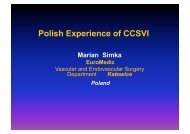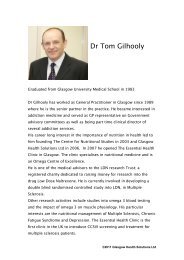ISNVD Abstract Book
ISNVD Abstract Book
ISNVD Abstract Book
Create successful ePaper yourself
Turn your PDF publications into a flip-book with our unique Google optimized e-Paper software.
Introduction<br />
Cardiac Effects In The Multiple Sclerosis Patient – Implications For<br />
Avoidance Of Restenosis After CCSVI Angioplasty<br />
Driscoll DL, Francomano CA<br />
The Harvey Institute For Human Genetics<br />
Multiple sclerosis patients suffer from numerous neurological and inflammatory symptoms and signs. For this reason, focus on this disease process and appropriate treatments has been centered on the neurological insults to the brain<br />
and central nervous system, and more recently, has included evidence of abnormal venous drainage from the brain (CCSVI – “Chronic Cerebrospinal Venous Insufficiency”) and related abnormal fluid dynamics. Little attention has<br />
been paid to the cardiac effects of multiple sclerosis, but a review of literature indicates that such evaluation may provide critical information as to the pathogenesis and treatment of multiple sclerosis, including reducing the frequency<br />
of restenosis in the patient treated with angioplasty for CCSVI.<br />
A review of the literature indicates that multiple sclerosis patients (as studied by Akgul F, et al) demonstrate subclinical left ventricular diastolic dysfunction (P < 0.05). The cause of left<br />
ventricular diastolic dysfunction (when not secondary to medications such as mitoxantrone) is the overproduction of inflammatory cytokines such as TNF-alpha (Tumor Necrosis-alpha),<br />
Interleukin-6 (IL-6) and Interleukin-1 (IL-1) – all are mast cell mediators.<br />
For approximately a decade, these inflammatory cytokines have been implicated in the development and progression of heart failure. Additionally, TNF-alpha is known to promote and activate thromboembolism. The actions of such<br />
inflammatory cytokines in combination with the activation of Matrix Metalloproteinase (MMP) is assumed to cause collagen breakdown in the heart, and cardiac mast cells play an important role in the initiation of this process.<br />
Similar changes of collagen are occurring in the veins of patients with CCSVI. The study of mast cells and their granulations is critical when reviewing the potential causes of CCSVI and the avoidance of restenosis in the CCSVI<br />
patient.<br />
Purpose<br />
M.S. patients develop left ventricular diastolic dysfunction (LVDD). 1<br />
Ehlers-Danlos Syndrome (EDS) patients also develop LVDD. 2 Many, if not all,<br />
EDS patients who develop autonomic dysfunction also have CCSVI.<br />
Inflammatory cytokines are higher in<br />
the MS patient<br />
Red whiskers indicate the standard error of the<br />
mean cytokine response in MS patients vs.<br />
normals. Reference:<br />
* Diagram: Martins T, Rose J, et al. Analysis of<br />
Proinflammatory and Anti-Inflammatory Cytokine<br />
Serum Concentrations in Patients with Multiple<br />
Sclerosis by Using a Multiplexed Immuno assay. Amer<br />
J of Clin Path. 2011;136(5):696-704<br />
What occurs on a molecular and chemical level in LVDD and congestive heart failure?<br />
Can the cause of the changes seen in myocardial tissue reflect the disease process in<br />
M.S. and/or the cause of restenosis?<br />
Can this information give us new targets for<br />
treatment of M.S. and<br />
PREVENTION OF RESTENOSIS?<br />
Methods/Result: Literature Review<br />
Increase in myocardial stress<br />
Release of TNF-alpha,<br />
Methods/Result: Literature Review<br />
(such as increased ventricular<br />
volume or pressure),<br />
independent of the underlying<br />
cause, results in 13<br />
Increased release of<br />
ET-1 (a powerful<br />
vasoconstrictor) 16<br />
Mast cell degradation 16<br />
MMP (Matrix<br />
metalloproteinases)<br />
activation 7<br />
Ventricular<br />
Remodeling LVDD 5<br />
IL-1, IL-6 3,4,5,14<br />
Increase in cytokine<br />
elaboration follows in<br />
direct relation to the<br />
severity of the disease<br />
Proteases released include<br />
Chymase and Tryptase,<br />
which, in combination<br />
with other inflammatory<br />
cytokines 6,7 cause<br />
“mediator release<br />
syndrome”<br />
Collagen degradation:<br />
(in vessels, change of collagen<br />
from collagen 1 to collagen<br />
3 12,15 )<br />
Inflammatory cytokines<br />
cause numerous<br />
harmful effects (when<br />
out of balance with<br />
anti-inflammatory<br />
cytokines): fibrosis,<br />
inflammation,<br />
endothelial cell<br />
apoptosis,<br />
thromboembolism, up<br />
regulation of cell<br />
adhesion molecules,<br />
etc. 8,9,10,11<br />
Inflammatory Cytokines + MMP = collagen change<br />
Collagen 1 becomes Collagen 3<br />
Potential Effects of TNF-alpha in Heart<br />
Failure: Could these effects also contribute<br />
to restenosis?<br />
•Produces left ventricular dysfunction<br />
•Produces pulmonary edema in humans<br />
•Produces cardiomyopathy in humans<br />
•Activates thromboembolism experimentally<br />
•Promotes thromboembolism experimentally<br />
•Promotes abnormalities in myocardial metabolism<br />
experimentally<br />
•Produces B-receptor uncoupling from adenylate<br />
cyclase experimentally<br />
•Abnormalities in mitochondrial energetics<br />
•Activation of the fetal gene program experimentally<br />
•Produces cardiac myocyte apoptosis experimentally<br />
Conclusion:<br />
Understanding the mechanisms<br />
involved in LVDD in the M.S. or EDS<br />
patient, and accepting that vascular<br />
changes are part of the disease process<br />
in both conditions, new and unique<br />
opportunities for treatment and<br />
prevention of restenosis come to light.<br />
New medications may include those that block histamine<br />
(H1 and H2 antagonists), mast cell stabilizers (cromolyn<br />
sodium and ketotifen), leukotriene blockers<br />
(montelukast), prostaglandin blockers (aspirin), flavinoids<br />
(including quercetin and luteolin), juanbi.<br />
TNF-alpha blockers: many medications for rheumatoid<br />
arthritis target TNF-alpha, but new medications with<br />
fewer side effects are also available.<br />
IL-1 blockers (anakinra, and many IL-6 blockers),<br />
Chymase inhibitors<br />
ET-1 blockers: bosentan, sitaxentan, ambisentan<br />
IL-6 blockers (statins, aspirin, indomethacin)<br />
Mast cell trigger avoidance should be considered as<br />
part of the post-angioplasty protocol.<br />
References<br />
1. Akgul F, McLek I, Duman T, Seyfeli E, Seydaliyeva T, Yalcin F. Subclinical left ventricular dysfunction in multiple sclerosis. Acta Neurol Scand. 2006 Aug; 114(2):114-8.<br />
2. McDonnell N, Gorman B, Mandel K, Schurman S, Assanah-Carroll A, Mayer S, Najjar S, Francomano C. Echocardiographic Findings in Classical and Hypermobile Ehlers-Danlos Syndromes. American Journal of Medical Genetics 2006;<br />
140A:129-136<br />
3. Kapadia S, Dibbs Z, Kurrelmeyer K, Kaira D, Seta Y, Wang F, Bozkurt B, Oral H, Sivasubramanian N, Mann DL. The role of cytokines in the failing human heart. Cardiol Clin. 1998 Nov;16(4):645-56 PMID 9891594<br />
4. Birks E, Burton P, Owen V, Mullen A, Hunt D, Banner N, Barton P, Yacoub M. Elevated tumor necrosis factor-alpha and interleukin-6 in myocardium and serum of malfunctioning donor hearts. Circulation. 2000 102:III-352-III-358.<br />
5. Baumgarten G, Knuefermann P, Mann D. Cytokines as Emerging Targets in the Treatment of Heart Failure. Trends Cardiovasc Med 2000;10:216-223<br />
6. Molderings G, Brettner S, Homann J, Afrin L. Mast cell activation disease: a concise practical guide for diagnostic workup and therapeutic options. J Hematol Oncol. 2011;4:10<br />
7. Janicki J, Brower G, Gardner J, Forman M, Stewart J, Murray D, Chancey A. Cardiac mast cell regulation of matrix metalloproteinase-related ventricular remodeling in chronic pressure or volume overload. Cardiovascres Oxford J. 2005<br />
Oct;69(3):657-665 PMID: 16376329<br />
8. Heikkila HM, Latti S, Leskinen MJ, Hakala JK, Kovanen PT, Lindstedt KA. Activated mast cells induce endothelial cell apoptosis by a combined action of chymase and tumor necrosis factor-alpha. Arterioscler Thromb Vasc Biol. 2008<br />
Feb;28(2):309-14. PMID: 18079408<br />
9. Gu Yang, Liu Chang, Alexander SJ, Groome LJ, Wang Y. Chymotrypsin-Like Protease (Chymase) Mediates Endothelial Activation by Factors Derived From Preeclamptic Placentas. Reprod Sci. 2009 September;16(9):905-913. PMCID:<br />
PMC 3062263<br />
10. Oyamada S, Bianchi C, Takai S, Chu LM, Sellke FW. Chymase inhibition reduces infarction and matrix metalloproteinase-9 activation and attenuates inflammation and fibrosis after acute myocardial ischemia/reperfusion. J Pharmacol Exp<br />
Ther. 2011 Oct;339(1):143-51. PMID:21795433<br />
11. Howard PS, Renfrow D, Schechter NM, Kucich U. Mast cell chymase is a possible mediator of neurogenic bladder fibrosis. Neurourol Urodyn. 2004;23(4): 374-82. PMID: 15227657<br />
12. Coen M, Mengatti E, Salvi F, Galeotti R, Mascoli F, Zamboni P, Gabbiani G, Bochaton-Piallat M. Characterization of CCSVI lesions in multiple sclerosis patients. <strong>Abstract</strong> for <strong>ISNVD</strong>, 2010.<br />
13. Munger MA, Johnson B, Amber IJ, Callahan KS, Gilbert EM. Circulating concentrations of proinflammatory cytokines in mild or moderate heart failure secondary to ischemic or idiopathic dilated cardiomyopathy. Am J Cardiol. 1996 Apr;77(9):<br />
723-7.<br />
14. Turnbull A, Rivier C. Regulation of the Hypothalamic-Pituitary-Adrenal Axis by Cytokines: Actions and Mechanisms of Action. Physiol Rev. 1999. 79;1-71 PMID: 9922367<br />
15. Palaniyandi S, Nagai Y, Watanabe K, Ma M, Veeraveedu P, et al. Chymase Inhibition Reduces the Progression to Heart Failure After Autoimmune Myocarditis in Rats. Experimental Biology and Medicine. 2007, 232:1213-1221.<br />
16. Murray DB, Gardner JD, Brower GL, Janicki JS. Endothelin-1 mediates cardiac mast cell degranulation, matrix metalloproteinase activation, and myocardial remodeling in rats. Am J Physiol Heart Circ Physioll. 2004 Nov;287(5):H2295-9.<br />
PMID: 15231495




